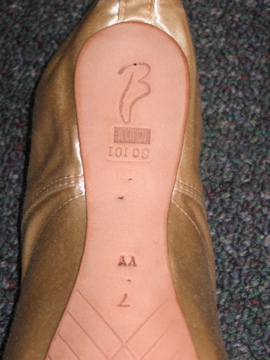Most pointe shoes are handmade by cobblers, or makers, who become highly specialized at their very specific jobs. Their work can be considered as much of an art as the work of the dancers who wear their shoes. They must be entirely consistent in their craft, because, although no two shoes will ever be identical, any shoe that is slightly misaligned or has creases in the fabric will be unwearable (Bentley, 1984). Each pair takes several days to complete, as they need time to dry at various stages. A single maker can work on up to 40 pairs of shoes a day, which is a rate necessary to keep up with the speed at which dancers need new shoes (Hanlon, 2005). Each maker in a factory identifies the shoes that he has made with a stamp of a certain symbol, somewhat like the branding of a cow.

The process of making a pointe shoe begins with cutting the material. Because pointe shoes have no specific right or left shoe, many pieces of fabric can be cut at once, as a measure towards consistency across different shoes and pairs of shoes. The next step is to sew together the three pieces of satin that make up the body of the shoe. A layer of cotton lining is also sewn in at this time. Seamstresses do both the cutting and sewing of the material, not the pointe shoe maker who ultimately gets to claim the shoe as his handiwork.
The maker is responsible for the series of steps that comprises the shaping and blocking of the shoe. It is often emphasized that pointe shoes are constructed inside out until the last minute, and that all shoes used to be made this way. This allows for smoother seams, but moreover, this construction is part of pointe shoe tradition. The shoe is given shape by a last, an ambiguous foot-shaped model, and the first layers of material are stretched across the last of the correct size. The maker then begins to build the box of the shoe by layering many layers of burlap, paper, and glue. This step is called blocking, as the box of the shoe is also known as the block. The sole of the shoe, a thick layer of leather, is added at this time.
The next step, lasting, ensures that all of the layers of fabric are lying flat, without any creases. At this point, the fabric that comprises the box is gathered and tucked under in pleats, so that all of the excess lies flat on the bottom of the shoe, right under the toes. Finally, the shoe is turned right side out, and shank is inserted. The last is put in the shoe again, so that the box can be properly shaped from the outside. In particular, the platform is made to be completely flat, as any lumps would make it impossible for a dancer to dance properly. Lastly, the shoes are set to dry for several days, giving the shoes time to harden (Barringer & Schlesinger, 2004).
How the Angelo Luzio company makes its shoes:
[]
While their process is perhaps not as traditional as that of some of the more established companies, the visual is extremely helpful for understanding the process.
